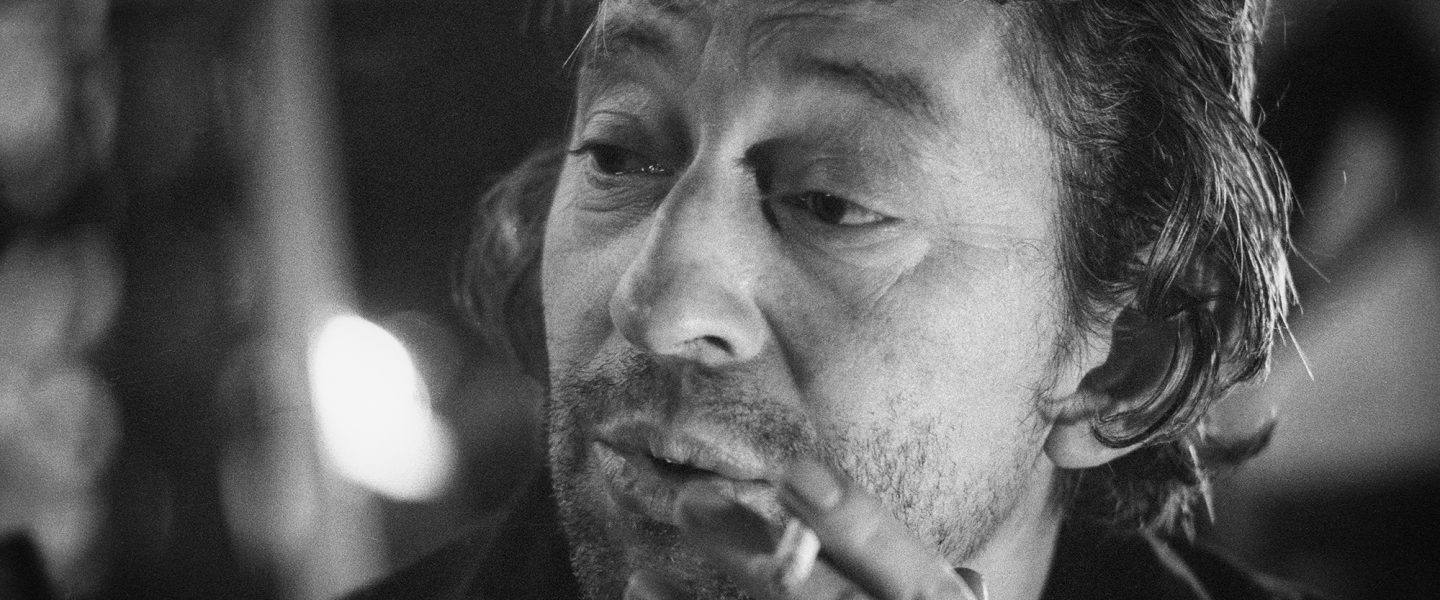Trying to decipher the French Dylan.
|
Listen To This Story
|
The singer and songwriter Serge Gainsbourg, who died in 1993, is such a palpable presence in Paris, it’s as if he were still wandering the streets at night, hailing a police car like a taxi and having the boys in blue happily drive the soused troubadour home to his expansive, cluttered house on the Rue de Verneuil.
That house, on the Left Bank near the Musée d’Orsay, is finally about to open its doors to the public. Long a shrine, it’s covered in loving graffiti and preserved inside the way he left it, no sculpture, guitar, or ashtray put out of place. Though lax about a lot of things, it was Gainsbourg’s fastidiousness about that house, in which nothing could be moved a jot even in his lifetime, that contributed to his breakup with Jane Birkin — that and the occasional beatings.
She still defends him. “You can’t judge things by other epoques,” she said in an interview with The Times. “You can’t measure them by this extraordinary state that MeToo has made.”
The critic Bertrand Dicale, author of Tout Gainsbourg, wrote, “The fact that Gainsbourg beat his girlfriends, we’ve always known that. You had to be a complete idiot not to know that. Of course Gainsbourg was a nasty guy, but a lot of artists are.”
Ah, the Gallic salute to art!
Overseen by Gainsbourg’s family, the house will include a museum, a bookstore and Le Gainsbarre, a hybrid space that hosts a café during the day and a piano bar at night.
But it’s the house itself that promises to show a side of the French icon not heretofore seen — his collections, style, and taste in household appliances. For the French, it will be like Francis Bacon’s studio, Jimi Hendrix’s Mayfair flat, and Oscar Wilde’s Père Lachaise grave, all rolled into one.
The extent of the clutter and the lack of wheelchair access is said to be the cause of the repeated postponements, but I wonder if daughter Charlotte, who used to live there, and who refused for four days to give up her father’s body — he died there on March 2, 1991 — is getting cold feet about sharing this shrine with the riffraff.
But everyone here, including the riffraff, really loved him. For the uninitiated — that is, most of the world population outside France — an explanation of the Phénomène de Gainsbourg is in order.
In the English-speaking world, Gainsbourg is most famous (only famous?) for being the father of actress/singer Charlotte Gainsbourg, the partner of singer/bag designer Jane Birkin, and the creator of a pop song so dirty it was banned from radio for years, even though hardly anyone could understand the words. Not that you needed to follow the words to figure out what it was about.
“Je t’aime… moi non plus” (“I love you… me neither”), originally recorded in 1967 with international sex symbol Brigitte Bardot, was so dirty not even Bardot wanted it released (she was afraid it would upset her husband).
Gainsbourg had to rerecord it the following year with sexy string bean Birkin, who contributed “heavy breathing” along with the lyrics. When it was finally released in February 1968 it became a notorious worldwide hit, despite being banned by the BBC and the Pope (or perhaps because of it).
You’ve heard the song, with its memorable organ riff and naughty French words, but it’s not what the French think their patron saint really should be remembered for. If anything it was a bit of a blague, or naughty joke, the mischievous Serge seeing what he could get away with.
He could get away with pretty much anything.
Ironically, when I asked various Parisians to describe Gainsbourg for me, the word pudique kept coming up. There’s not a precise translation of that word into English, but it combines the various qualities of modesty, prudishness, discretion, and correctness.
You could also say it means traditional and old-fashioned, and I think that goes some way to explaining his outdated attitude towards the ladies, a not-uncommon position of his time that the sexual revolution was for men, not for women.
His 550 songs included “Les Sucettes” (The Lollipops), which he wrote for France Gall, a teenage pop star who claimed she didn’t realize the suggestive nature of the song’s lyrics when she recorded it.
He may have consistently shocked the French bourgeoisie, but the proletariat he often encountered on his late-night jaunts — taxi drivers, policemen, refuse collectors — loved him, maybe because they thought he stuck his thumb in the eye of society on their behalf.
English-speaking music lovers may think he stuck his thumb in the eye of music for his own amusement, but the French put him up there with Dylan.
What interests me are his various twisted song cycles, such as Histoire de Melody Nelson (The Story of Melody Nelson), which Wikipedia says is “considered by many critics and fans to be Gainsbourg’s most influential and accomplished work as well as one of the greatest French-language albums in French pop history.”
It’s about a middle-aged man who, when he’s out driving his Rolls Royce Silver Ghost, accidentally hits a British teenage girl (Birkin) out riding her bicycle. He scoops her up and puts her in the car, and they end up having a steamy affair. I kind of appreciate the bonkers lunacy of that one.
Serge liked tweaking noses (and more) and did so again with his single “Lemon Incest,” a duet with his then 12-year-old daughter Charlotte, seen in bed in the video in her panties with her shirtless dad. That one didn’t quite make the charts in the US, but it reached #2 in France and charted there for 13 weeks. Charlotte has always stood up for it, calling it “very innocent” and “very pure.”
Gainsbourg had something of a genius for causing offense, and I don’t want to pile it on, but he once told Whitney Houston live on French TV that he wanted to “f***” her — helpfully in English so she could understand. Maybe not the most pudique behavior, but the French defended him, explaining that he just liked to be outrageous. (I think he also just wanted to f*** Whitney Houston.)
This is the guy who, when he died, French President François Mitterrand called him “our Baudelaire, our Apollinaire,” and attended his funeral.
The French take him seriously but not literally, but to my mind he only makes sense if you don’t take him seriously or literally. But then how was he Mitterrand’s Baudelaire, his Apollinaire?
For that we need a brief history lesson, because a key to understanding this hugely prolific and talented outrage machine is to remember what an outsider he really was. A short, shy Jewish man with big ears, he’d experienced antisemitism on a grand scale in his youth. His parents recognized his abilities as a musical prodigy, but he was forever haunted by the Jewish star he’s been forced to wear during the occupation, and his family narrowly avoided capture by the Nazis by traveling from Paris to Limoges under false papers.
 After that, he didn’t particularly care whose feathers he ruffled, and he always carried the air of a careless stray, a bohemian alley cat, which in turn was catnip to women (including Catherine Deneuve, besides Bardot and Birkin) who thought they could domesticate him. Spoiler alert: They couldn’t. Birkin says he never took a shower, but was still somehow the cleanest person she’d ever met. Could he also walk on the Seine? Turn the Pellegrino into Pinot Noir?
After that, he didn’t particularly care whose feathers he ruffled, and he always carried the air of a careless stray, a bohemian alley cat, which in turn was catnip to women (including Catherine Deneuve, besides Bardot and Birkin) who thought they could domesticate him. Spoiler alert: They couldn’t. Birkin says he never took a shower, but was still somehow the cleanest person she’d ever met. Could he also walk on the Seine? Turn the Pellegrino into Pinot Noir?
There are some today who think of him as nasty, brutish, and short, but rumors of his cancellation have been greatly exaggerated. The Pompidou Center is currently showing an exhibit of his books and manuscripts (it runs through May), and, until her stroke a couple of years ago, Birkin toured the world singing his songs. The man even has his own postage stamp.
I said earlier that Gainsbourg could get away with anything, but that’s not strictly true. He couldn’t get away with smoking five packs a day and drinking every night (you rarely see photographs of him without an unfiltered Gitane jutting out of his mouth or artfully displayed between his fingers), and as a consequence died at the relatively young age of 63. The loss was instantly felt in France, one of those “Where-were-you-when-you-heard?” moments.
I’ve been trying to find an American equivalent, and of course John Lennon’s assassination comes to mind, but also David Bowie and Andy Warhol, all three of them adopted New Yorkers who were constantly seen about town (I remember spotting Bowie on the dance floor of the Mudd Club and Warhol in the elevator at the Whitney; alas I never bumped into Lennon). Gainsbourg was similarly such a presence in Paris, you couldn’t quite imagine the city without him.
Paris survived, but time has forever stopped at 5, Rue de Verneuil, and walking through those doors will be like a visit to a curious world, before #BalanceTonPorc (i.e., “out your pig,” the French #MeToo), AIDS, and cancel culture, when everyone smoked, stayed up till dawn, and then made love until morning. But even with that busy schedule, on the Rue de Verneuil, one man was also writing songs that would shock and confuse many around the world, but reach into the very heart of his own country.
—
J.B. Miller is an American writer living in England, and is the author of My Life in Action Painting and The Satanic Nurses and Other Literary Parodies.




